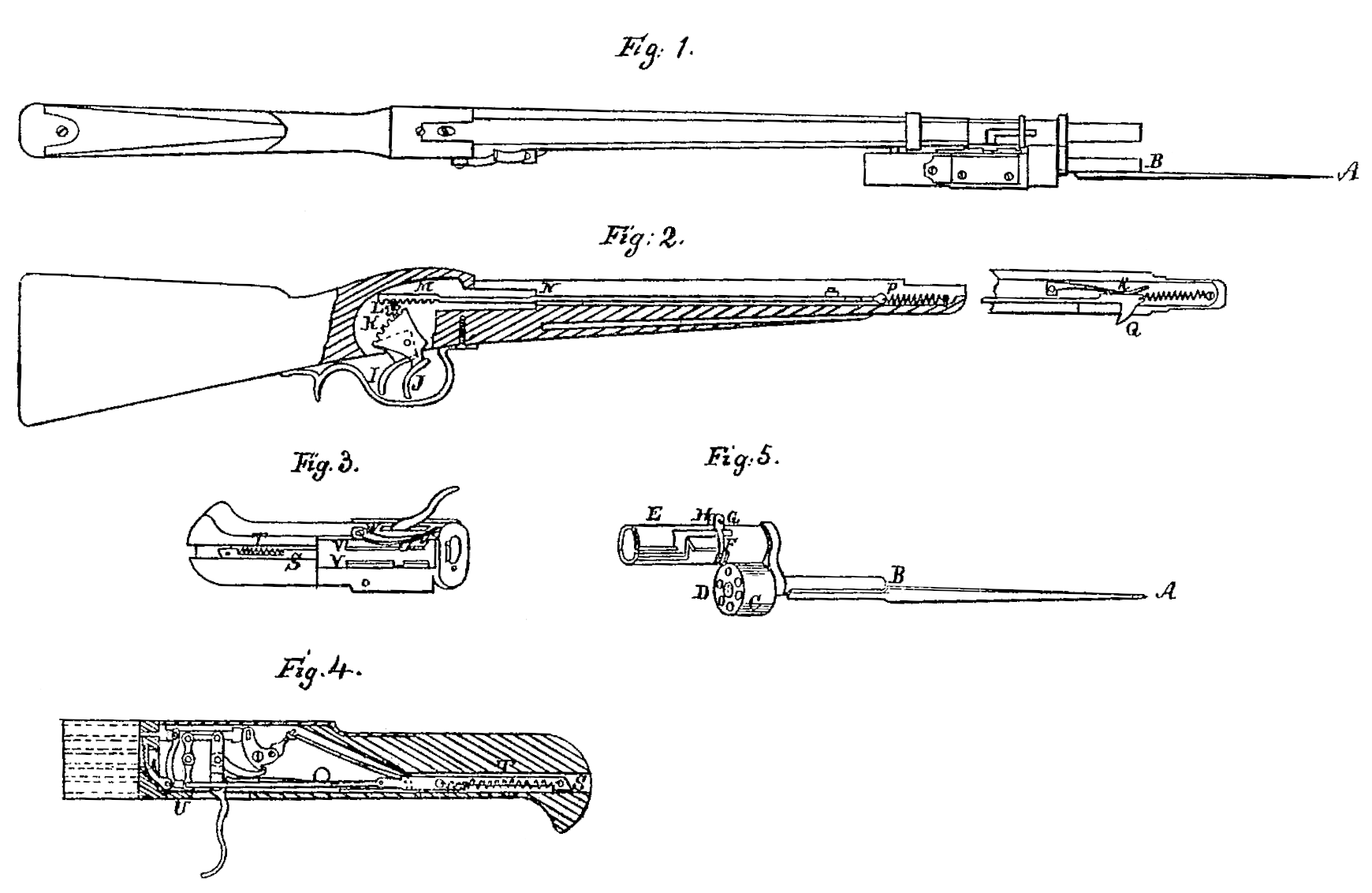US 44784
UNITED STATES PATENT OFFICE.
ROBERT. K. COLVIN, OF LAN CASTER, PENNSYLVANIA.
IMPROVEMENT IN COMBINED GUN AND PISTOL BAYONET.
Specification forming part of Letters Patent No. 44,784, dated October 25, 1864.
To all whom it may concern:
Be it known that I, Robert K. Colvin, of the city of Lancaster, county of Lancaster, and State of Pennsylvania, have invented new and useful Improvements in Gun, Pistol, and Bayonet Combined; and I do hereby declare the following to be an exact description thereof, reference being had to the accompanying drawings, and to the letters of reference marked thereon, making a part of this specification.
The nature of my invention consists in the attaching a pistol and bayonet on the side near the muzzle of the gun— having a rod extending from the pistol to the lock of the gun— where two triggers are located, one to operate the gun, the other to operate the pistol.
To enable others skilled in the art to make and use my invention, I will proceed to describe its construction and operation.
Figure 1 represents a view of the gun, pistol, and bayonet combined; Fig. 2, a view of the trigger and rod to operate the gun and pistol; Fig. 3, the one side of the pistol sock, with its connecting-flanges; Fig. 4, the opposite side of the pistol-stock, exhibiting a sectional view of its devices. Fig. 5 represents the bayonet, pistol barrel, and cylinder combined.
A represents the bayonet and barrel B of the pistol, solid in one piece, and at the lower end of the barrel (at the side) the revolving cylinder C of the pistol is attached by a center screw, D, upon which the cylinder-revolves.
E is the socket of the bayonet, by which the bayonet is attached to the barrel of the gun. Around the center of the socket is a band, F, with ears G, that are held together by a screw, H, and which is the usual mode of fastening the bayonet to the gun.
At the lock of the gun, which is an ordinary percussion-lock, with its trigger I, is an additional trigger, J. This trigger J has on the inside a segment-ratchet, K, that operates on a small pinion-wheel, L, that gears into and operates a horizontal rack, M, so as to draw the rack M backward. To the front part of this rack M is attached a wire rod, N, that extends along the stock of the gun in a groove underneath the barrel of the gun to near the upper end of the stock, where a spiral spring, P, is attached to the rod N and to the end of the stock, so as to draw the rod N forward and always set itself ready for the action of the trigger J. The upper end of the rod N is a flat bar, with a dog, Q, projecting through the side of the stock of the gun, aid has a flat spring, R, behind the bar to force the dog Q to its place. This dog Q hooks or catches into a slot in a steel spring or bar, S, and draws the bar back, while the spiral spring T throws the bar forward to its place, setting itself. The forward end of the bar S is attached to the lower end of a pivot-lever, U, that operates the moving devices of the pistol, these devices being the common devices of an ordinary revolver.
The pistol-stock has a plate with two flanges, V V, which slide upon the socket of the bayonet, and a hooked spring, W, that falls into a notch in the flanges V V, and thus holds and fastens the pistol firmly to the barrel of the gun.
This invention of mine can be attached to any gun. The advantages are in close quarters or in a charge. The gun being fired, the pistol is then operated, and afterward the bayonet can be used.
What I claim as my invention, and, desire to secure by Letters Patent, is—
1. The arrangement and combination of two triggers, to operate a gun and a revolving pistol separately or together, as herein described.
2. The arrangement and combination of the gun, pistol, and bayonet, when arranged and combined as herein described.
ROBT. K. COLVIN.
Witnesses:
J. Franklin Reigart,
John S. Hollingshead.

